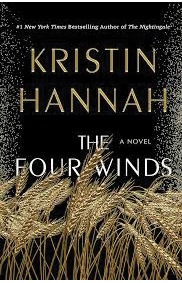
The Four Winds is not an easy book to read. It’s not one to cheer you up on a dismal day, or to help you sleep at bedtime. It is gritty, often grim, and altogether real–based on historical records from the time of the Dust Bowl and the Great Depression. It is an unforgettable book, with echoes that reach into our own era, particularly the story the plight of migrant workers who have fled in desperation to California–a story which resounds in some ways in the experiences of would-be immigrants on our southern borders.
The main character in the book is Elsa, a mother of two young children, whose husband has deserted her and who sees no relief from the killing dust storms in Texas except to take her children on the road and head for the land of milk and honey. Alas, that land is cold and unforgiving and resentful of the hordes trying to find work to evade the starvation that stalks their every day. The reader can feel the poverty and despair and fear that haunt their lives, and ultimately the anger that leads to the formation of a workers’ union and a general strike.
In the beginning Elsa seems an unlikely heroine, born and bred to be meek and mild, almost passive in accepting her fate. But in regard to her children, Elsa is not at all passive. She manages to find work–humble, back-breaking, low-paying work, to be sure–but enough to sustain life. The three of them survive somehow, with momentary rays of light provided by relationships–notably the love of Elsa’s mother-in-law, her friendship with another woman in the migrant camp, and at the end of the book by a radical union organizer whom she meets along the way.
Although there is no happy ending in the book for Elsa, there are hints that her daughter will achieve the success that her mother has dreamed of. Yes, The Four Winds is hard to read; it is intense and even tedious in its detail, giving the reader a remarkably clear picture of the lives of its characters and the hopelessness of their situation; but its strongest message has to do with the humanity of the main characters, the strength they find in themselves, and the bonds of affection that survive everything. This is history at its most vivid.